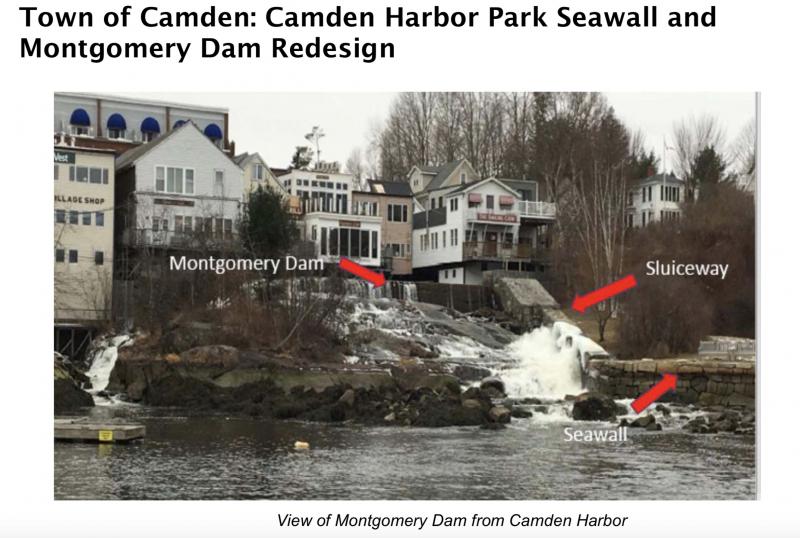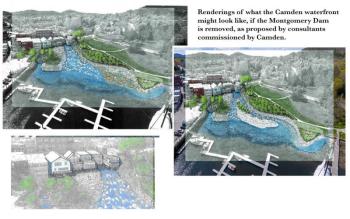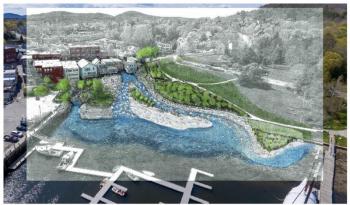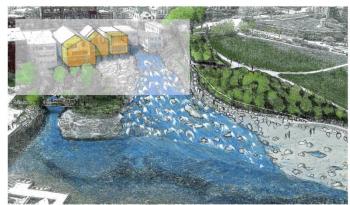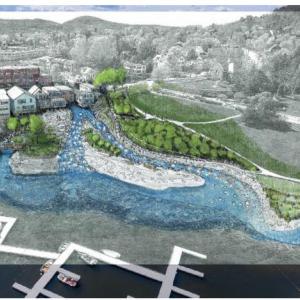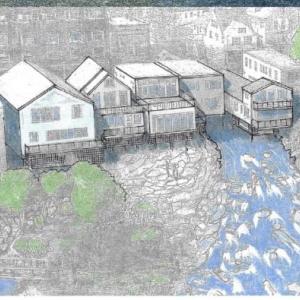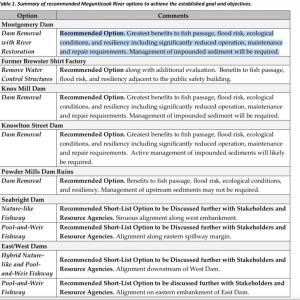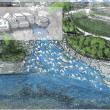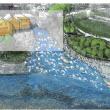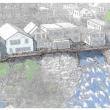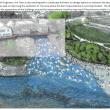Camden Select Board invites public to Harbor Park for site walk, workshop about Megunticook River report
CAMDEN — Weather permitting, the Camden Select Board is convening a public workshop at Harbor Park, Oct. 14, and inviting those consultants, engineers and scientists who have been involved with a multi-year Megunticook River management assessment, which includes the idea of removing the Montgomery Dam, at the head of Camden Harbor.
The latter has been contentious, and the town is trying an outdoors workshop approach to engage the public. Inviting public stakeholders outdoors and to the site, instead of meeting in a conference room or auditorium, is to provide more opportunity for contextual conversation.
“There is an advantage to having people in the environment of whatever topic you are discussing,” said Select Board Chairman Bob Falciani. “It allows people to be interactive. A lot of people don’t like to ask questions in a formal meeting. They are more likely to ask pointed questions when they are one-on-one or one-on-two.”
While the removal of the Montgomery Dam has been most debated, it is but one part of a larger Megunticook River focus, as explained in the 200-plus page Megunticook River Feasibility Report. Recommendations also include removing the Knox Mill dam.
That report, published July 31, 2021, was prepared by Inter-Fluve, a firm which, it says at its website, “specializes in investigations, design, and restoration of rivers, lakes, estuaries and wetlands,” and Rockport engineering company Gartley and Dorsky.
Funding for the report derived from a $139,000 National Coastal Resilience Fund 2019 grant.
The report’s overarching purpose was to: “Identify and implement river management options for the Megunticook River that improve flood and community resilience, restore habitat connectivity and ecosystem health, reduce infrastructure management needs, and enrich community values and experiences through enhanced public access and use, educational value, acknowledgement of Town history, and landscape aesthetics.”
UPDATE:The presenters will be spread out at along the waterfront portion of Harbor Park and for those in the public who have a hard time walking on grass or inclines, the town “will have to accommodate,” said Falciani.
He said there will be chairs there for those who want to sit down.
An outdoor, onsite workshop approach to talking with the public, “is common and held all over the world,” said Falciani. “The only negative part, of course, is the weather.”
The workshop follows months, several years even, of increasingly frequent conversations about the dams along Megunticook River, and removing the Montgomery dam, which is at the head of Camden inner harbor, where the river empties into the ocean.
The dam was built in 1771, according to a short history of Camden’s dams that is included in the Megunticook River Feasibility Report. It initially supported a grist mill, and later, an anchor factory. Rebuilt in the 1930s, it was used for hydro-power in the 1980s.
“The dam was transferred from the Montgomery family to the Town in 1993, who operates the dam during rain events to prevent inundation of the lower levels of the buildings located over the small impoundment,” the report said. “More detail on the history of the Montgomery Dam and surrounding area is provided in the 2019 feasibility study (Inter‐Fluve and Gartley & Dorsky).”
That 2019 study, “found that the dam significantly increases flood risk in the downtown area while also creating the first in a series of fish passage barriers to species including alewives, blueback herring, sea-run brook trout, and American eel,” the 2021 study said. “The study also found that dam removal would provide the lowest cost option to the Town over the next 50 years and be the most likely to receive outside funding from environmental organizations and state and federal agencies due to increased flood protection and access to habitat.”
With a $40,000 planning grant from the Maine Coastal Program 2020, the town proceeded to engineer and design plans for the partial or full removal of the Montgomery Dam and the reconfiguration of the seawall and adjacent area in Camden’s Harbor Park.
“The project will result in a final design for modifications to the Montgomery Dam and reconfiguration of the adjacent seawall and adjacent area in Harbor Park to improve coastal and inland flood resilience and the passage of fish and other species from Camden Harbor up the Megunticook,” said the Maine Coastal Program, in its explanation of the money to be spent. “Overall this project is an essential step in addressing more frequent storm surge events and improving the health of the entire watershed.”
While there has been an increased number of different voices that support removing the dam for various ecological reasons, including fisheries.
“Native fish have been documented in strong numbers below Montgomery Falls, but unfortunately upstream passage is blocked directly above the falls by Montgomery Dam,” wrote Tom Johnson, chair of the Maine Chapter of Native Fish Coalition. “This includes river herring, American eels, and sea-run brook trout, a diadromous lifeform known as salters.”
But there has likewise been growing opposition to the dam’s removal by residents.
In late July 2021, the Save the Dam Committee organized and stated its members were: “concerned that town officials of Camden have failed to maintain the dam and have not expressed concern or respect for the value that the waterfall continues to offer Camden. The group feels that town officials have also failed to offer the people of Camden any public hearing or a range of options regarding the future of the dam.”
The committee said its goal was to preserve the legacy and beauty at the head of Camden Harbor by offering the people of Camden a choice to preserve both the Montgomery Dam and the Olmsted design of Harbor Park.
The Save the Dam Committee also maintains a Save the Dam Falls Facebook page.
There is also an independent survey that circulated by Emily Lusher about the The survey is available here: https://www.surveymonkey.com/r/V3SV6ZG and can be completed on a computer, tablet or phone. Paper copies are available at the Camden Deli, Smiling Cow, Marriners, Leather Bench, and Mahogany Salon. The survey is open until today, October 12.
Because the dam and the Camden Falls are intricately woven into Harbor Park, owned by the Camden Public Library, the library created a special committee in 2021.
The trustees of the Camden Public Library were given the power, authority, and duty to manage and control the Library, the Amphitheater, Harbor Park, and all things connected therewith, as stipulated in the original gift to the people of Camden by Mary Louise Curtis Bok, according to a March 2021 statement.
Representatives of the library had met with Select Board members, and in its public statement, the library said: “While there is a tendency to view the Harbor Park seawall and Montgomery Dam as one project, they are, in fact, two separate issues which may, or may not, have one solution. Our task is not to decide on the dam, but to set benchmarks for endorsing any plan for Montgomery Dam.”
Those benchmarks included preserving the original Olmsted design, that the park be even more user-friendly, and that the town, “actively engage with the public on these matters and to present alternative designs for Montgomery Dam, the mouth of the river, Harbor Park, and the head of the harbor.”
The town’s Select Board and Town Manager have been firm in their commitment to advancing the Megunticook River assessment, and state: “Any decisions about whether to move forward with construction plans will require multiple levels of approval from the Select Board, the Library Board of Trustees, and finally Town voters. No decision has been made and your input will help us determine the next steps in the process. At this point, we know that the dam and seawall require significant investment and that doing nothing is not an option. Significant grant funding is available for projects that restore habitat, reduce storm risk, and implement nature based solutions that require little to no maintenance.”
Reach Editorial Director Lynda Clancy at lyndaclancy@penbaypilot.com; 207-706-6657






